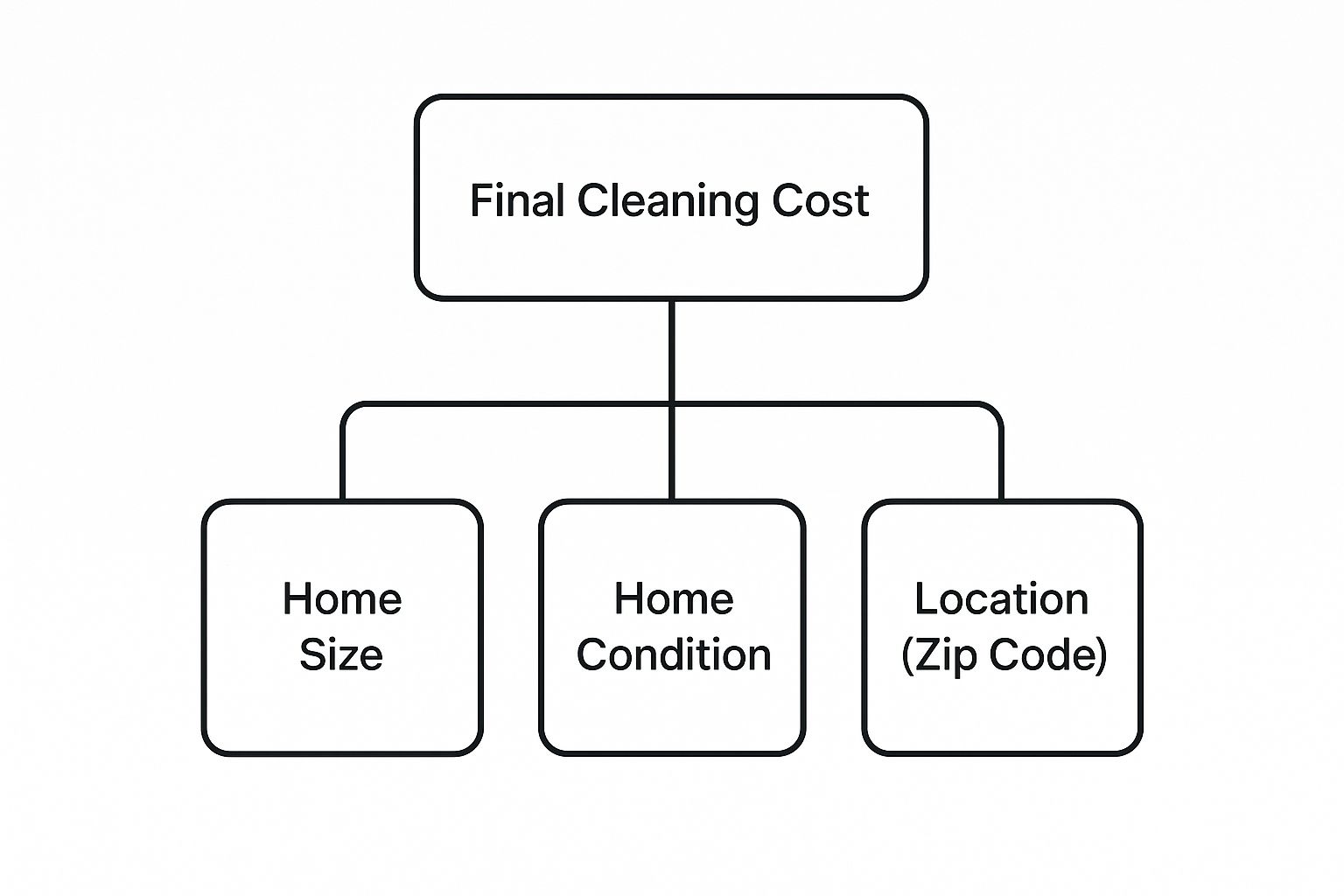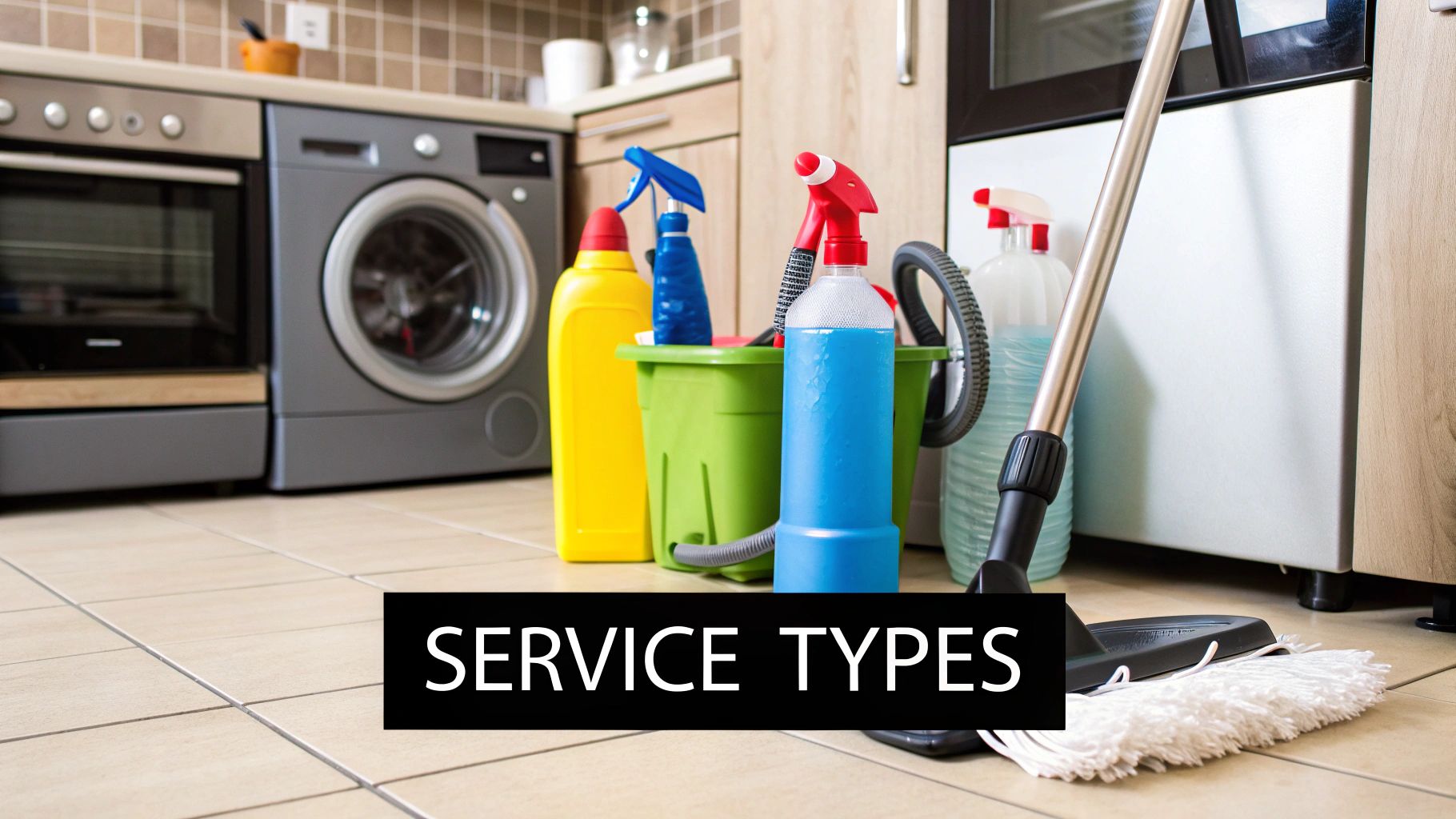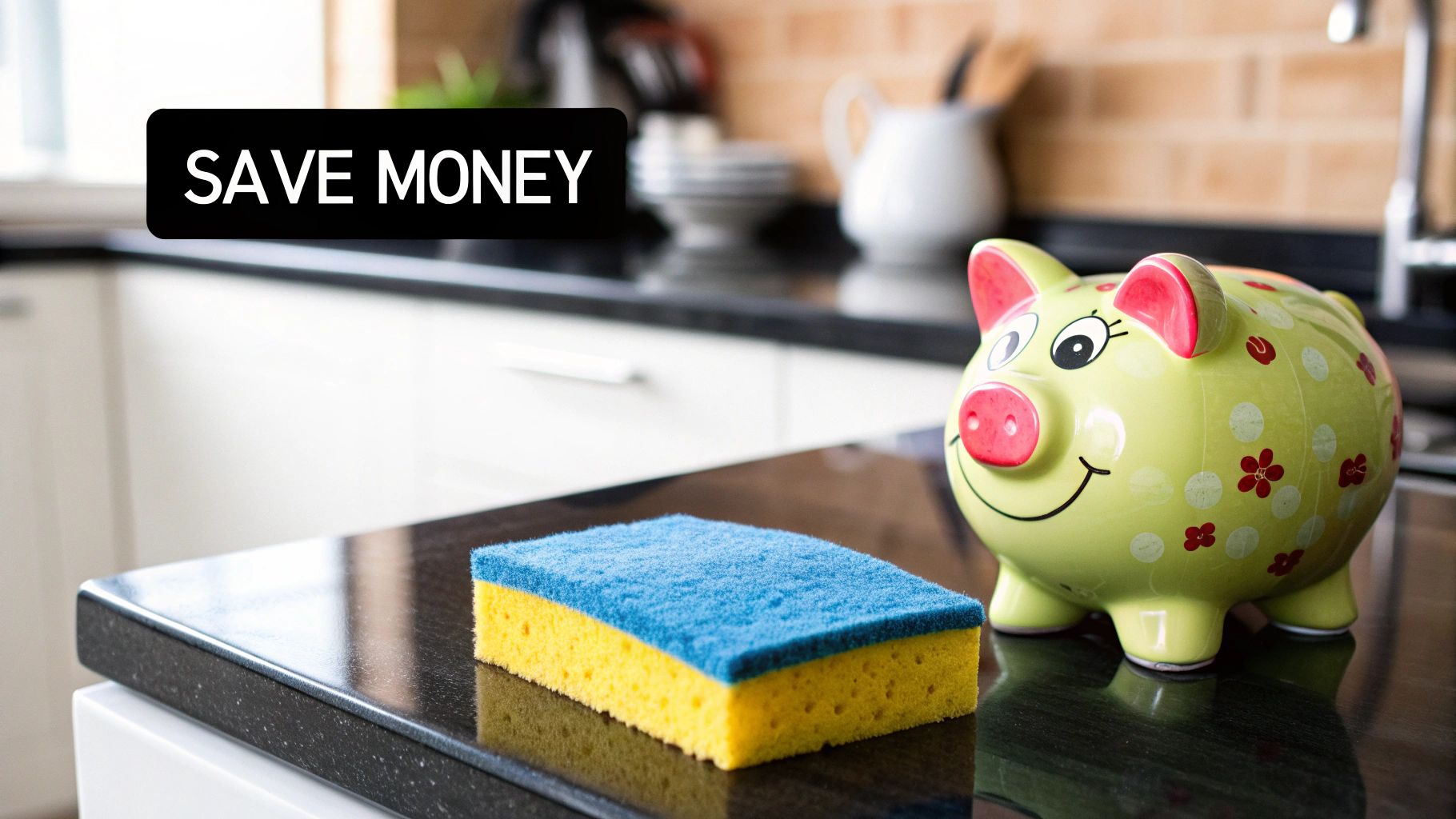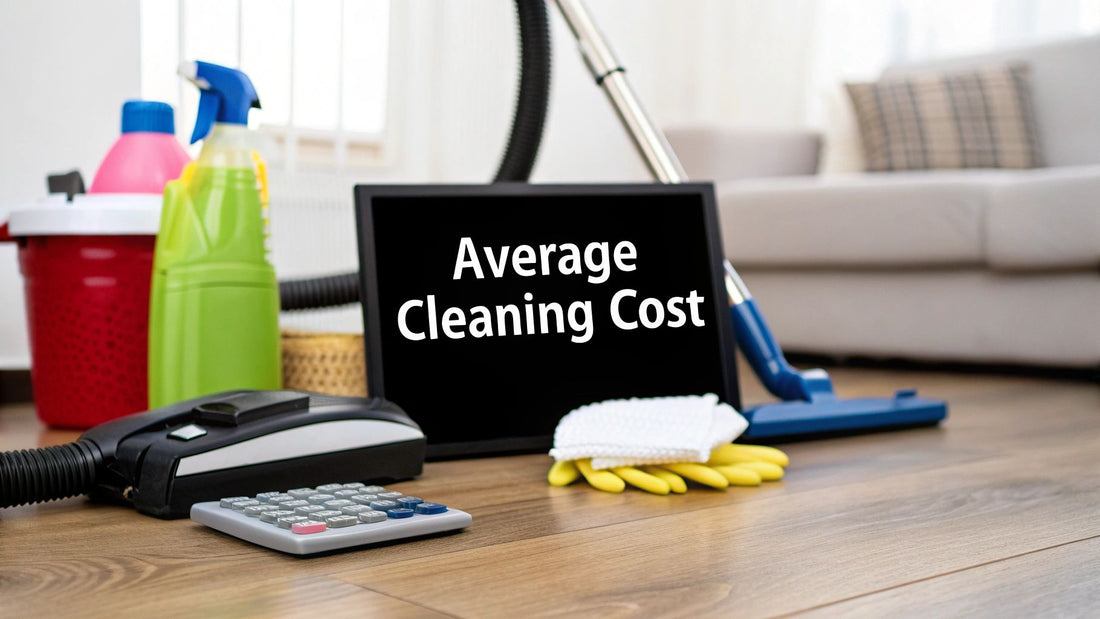So, you’re thinking about hiring a professional cleaner but have no idea what it’s going to cost. You’re not alone. On average, most homeowners find the national average cost of a house cleaning service lands somewhere between $170 to $220 per visit. But that's just a starting point—the final price tag can swing quite a bit depending on where you live, the size of your house, and exactly what you need done.
What Is the Average Cost of a House Cleaning Service

Before you start calling around for quotes, it helps to have a solid baseline in mind. For a standard, routine cleaning, you can generally expect to pay between $170 and $220 for a single visit. That often works out to about $50 per hour for each cleaner on the job, which is a great number to keep in your back pocket for budgeting.
Of course, not all cleaning jobs are the same. A "deep clean" is a whole different ballgame—it’s far more intensive and, you guessed it, more expensive. For an average-sized home, a deep clean can run anywhere from $200 to $400. For larger homes or particularly tough jobs, that price can easily climb past $1,000.
To get a feel for how these prices are put together, let's look at the common ways cleaning companies charge for their work.
Typical House Cleaning Costs at a Glance
Here’s a quick table to break down the most common pricing models and what you can generally expect to pay.
| Service Type | Average Hourly Rate (per cleaner) | Average Flat Rate (per visit) |
|---|---|---|
| Standard Cleaning | $25 – $50 | $120 – $180 |
| Deep Cleaning | $35 – $75 | $250 – $450+ |
| Move-In/Move-Out | $40 – $80 | $300 – $600+ |
These numbers give you a solid idea of the investment, but remember they're just averages. The final quote will always depend on your specific needs.
Common Pricing Models
Getting a quote that makes sense starts with understanding how companies structure their fees. You'll almost always run into one of these three models:
- Hourly Rates: This is pretty straightforward. You pay for the time it takes, typically between $20 to $50 per hour for each cleaner.
- Flat Fees: Many companies prefer to give you a set price for the entire job. For a standard home, this usually falls in the $100 to $170 range.
- Per-Room Costs: This one is less common, but some services charge by the number of rooms. For example, they might quote $100 for a one-bedroom, one-bathroom apartment.
If you want to see how these pricing structures break down for weekly, bi-weekly, or monthly services, our guide on house cleaning prices is a great resource.
It can also be helpful to see how other service industries itemize their costs. Looking at something like a service's pricing breakdown for moving can give you a better sense of how different factors contribute to a final quote.
Key Factors That Influence Your Final Cleaning Bill
Ever wonder why your neighbor’s cleaning quote was $150, but yours came back at $300? That final price isn't just pulled out of a hat. It’s a careful calculation based on the unique details of your home. Understanding these variables is the key to decoding your quote and seeing exactly where your money is going.
Think of it like getting a car repaired. The final bill depends on the car's model, how bad the damage is, and even the mechanic's zip code. House cleaning costs work the same way, with three main factors building the foundation of every estimate.
This infographic gives a great visual breakdown of what goes into your final cleaning cost.

As you can see, your home's size, its current condition, and where you live are the three pillars holding up the final price. Let's dig into how each one really impacts the bottom line.
Your Home's Size and Layout
This is the most straightforward factor. A bigger home just takes more time and resources to clean. It’s no surprise that a 3,000-square-foot house with four bedrooms and three bathrooms will cost more to clean than a 900-square-foot apartment. Simple as that.
But it's not only about the total square footage. The number of rooms—especially bathrooms and kitchens—plays a huge part. These areas are far more labor-intensive, demanding detailed scrubbing and sanitizing that adds to the overall time and, consequently, the cost.
Key Takeaway: More space, more rooms, and especially more bathrooms directly increase the time needed for a thorough job, which will always lead to a higher quote.
The Current Condition of Your Home
The starting point for your home's cleanliness is a major price driver. A house that's been regularly maintained will be a much quicker job than one that needs some serious TLC.
Imagine these different scenarios:
- Light Maintenance: Just a bit of dust and minimal clutter. Cleaners can get straight to standard tasks like wiping surfaces and vacuuming.
- Heavy Buildup: We’re talking visible soap scum, layers of grease on kitchen surfaces, and thick dust bunnies. This requires stronger products and a lot more elbow grease.
- Extreme Clutter: If a cleaning crew has to spend the first hour just tidying and clearing surfaces before they can even start cleaning, that extra labor gets factored into the price.
Basically, the more work it takes to get your home to a clean baseline, the higher that initial cost will be. This is exactly why a first-time deep clean is almost always more expensive than the follow-up maintenance visits.
Your Geographic Location
Where you live absolutely matters. The average cost of house cleaning service can swing wildly from one city to the next, mostly because of differences in the local cost of living.
For instance, a cleaning service in a major city like San Francisco has much higher overhead—wages, insurance, and even supplies cost more. A service in a small town in the Midwest just doesn't have those same expenses. Naturally, those operational costs are reflected in their pricing. A job that costs $150 in one area could easily be $250 or more somewhere else, for the exact same service on an identical home.
Comparing Different Cleaning Service Types

Not all cleaning services are the same, and the one you pick is a huge factor in the average cost of house cleaning service you'll end up paying. Think of it like ordering food: a quick sandwich is worlds apart from a five-course meal, both in effort and on the final bill. The same is true for cleaning your home.
A "standard clean" is your basic upkeep visit, meant to keep things tidy week after week. Then you have a "move-out clean," which is an all-out, top-to-bottom scrub designed to make a home look brand new for the next person. Knowing what's included in each service is the key to choosing the right one and not paying for work you don't actually need.
Standard Routine Cleaning
A standard cleaning is the most popular choice for recurring visits, like weekly or bi-weekly appointments. The whole point is to maintain the current level of cleanliness and stop dirt and grime from ever getting a chance to build up.
Typically, this service covers:
- General Tidying: Wiping down surfaces, dusting furniture, and making beds.
- Floor Care: Vacuuming all carpets and mopping hard floors.
- Kitchen Maintenance: Wiping countertops, the outside of appliances, and cleaning the sink.
- Bathroom Touch-Ups: Sanitizing toilets and sinks, plus wiping down mirrors and showers.
This is the service that keeps your home feeling consistently fresh and is the most budget-friendly option for regular maintenance.
Deep Cleaning Services
A deep clean is where things get serious. This is a much more intense service that gets into all the nooks and crannies a standard clean has to skip. We usually recommend this for a first-time service or as a big seasonal refresh—think "spring cleaning." In fact, checking out some comprehensive spring cleaning tips will give you a perfect idea of the detailed work that goes into it.
A deep clean is all about busting through that deep-seated grime and buildup. You can expect cleaners to be scrubbing tile grout, cleaning inside the oven and fridge, washing baseboards, and detailing window frames and light fixtures.
Because it’s so much more hands-on and time-consuming, a deep clean costs quite a bit more than a standard visit. If you want a full breakdown of the tasks that separate these two, you can learn more about the differences between a deep clean vs. a standard clean right here on our blog.
Move-In and Move-Out Cleaning
Move-in or move-out cleanings are the most thorough, no-stone-left-unturned services you can get. The goal is simple: restore a home to a like-new condition. This is often a requirement for renters who want their full security deposit back. It includes everything from a deep clean, plus a heavy focus on all the now-empty spaces.
Cleaners will get into:
- The inside of all cabinets and drawers.
- All closets, shelves, and storage areas.
- Wiping down every interior wall and baseboard.
- Scrubbing the inside of all appliances until they sparkle.
Since the home is empty, cleaners have full access to every corner without furniture getting in the way. This comprehensive scope makes it one of the pricier one-time cleaning services.
To make it even clearer, here's a quick look at how these services stack up against each other.
Comparing Cleaning Services Scope and Price
This table breaks down what you can generally expect from each cleaning package, along with a typical price range.
| Service Type | Common Tasks Included | Typical Price Range |
|---|---|---|
| Standard Cleaning | Dusting, vacuuming, mopping, surface wiping, basic kitchen & bathroom cleaning | $100 - $200 |
| Deep Cleaning | Everything in Standard, plus baseboards, inside appliances, window sills, grout scrubbing | $250 - $450 |
| Move-In/Out Cleaning | Everything in Deep, plus inside cabinets & drawers, closets, and wall spot cleaning | $300 - $600+ |
As you can see, the more detailed and time-intensive the job, the higher the cost. Choosing the right service ensures you get the clean you need without paying for extras you don't.
How Different Pricing Models Work
When you get a quote for cleaning, it’s almost always going to be one of two ways: an hourly rate or a flat fee. Figuring out how these work is the key to picking a service that fits your budget without any nasty surprises on the final bill. Each model has its own logic and works better for different kinds of cleaning jobs.
Think of it like hiring a taxi versus buying a bus ticket. An hourly rate is the taxi—you pay for the exact time spent, which is perfect for a custom, unpredictable trip. A flat fee is the bus ticket—you pay one set price for a defined route, no matter what traffic you hit.
The Hourly Rate Model
Paying by the hour is the go-to for jobs where the scope is a bit of a mystery. This is common for first-time deep cleans, post-renovation dust disasters, or homes that need a serious decluttering session before the real cleaning can even start. The flexibility of an hourly rate means cleaners can adapt to whatever the job throws at them without being stuck to a fixed price.
This model also puts you in the driver's seat. You can ask the team to spend extra time scrubbing the kitchen and just do a quick pass in the guest room, for example.
Expert Insight: For custom or one-off jobs, an hourly rate usually offers the best value. It ensures you're only paying for the work that actually gets done, which is ideal when the time needed is a big question mark.
Professional house cleaning costs reflect this, with average prices typically falling between $25 to $80 per hour per cleaner. The final number really depends on how complex the job is. For more on how the cleaning industry sets its prices, you can find some great insights on cleaning industry trends over at getjobber.com.
The Flat Fee Model
For regular, recurring service, the flat fee model is king. Once a cleaning company gets to know your home after an initial visit, they can accurately guess how long a standard clean will take. This lets them offer a consistent, predictable price for every visit—whether it's weekly, bi-weekly, or monthly.
The biggest win here is budget stability. You know exactly what you'll pay each time, making it much easier to plan your finances. This pricing structure is built on consistency and is the industry standard for ongoing maintenance. If you’re thinking about setting up regular service, understanding the weekly cleaning service cost can help you budget like a pro. A flat fee just takes all the guesswork out of the equation.
The Bigger Picture of Cleaning Industry Costs
Ever wondered what goes into the price of a professional cleaning service? It’s not just a number pulled out of thin air. That fee is directly tied to a massive global industry where labor costs, demand, and the real-world expenses of running a business all come together to set the rates in your area.
Seeing the full picture helps you understand your cleaning fee as more than a simple payment. It's an investment in a legitimate business that supports skilled professionals and keeps a dynamic economic engine running.
The Business Behind the Sparkle
Think of your local cleaning company just like any other small business on Main Street. They have real operational costs to cover just to open their doors and provide a reliable service you can count on. These aren't arbitrary charges; they reflect the genuine costs of doing business right.
What are these costs? It boils down to a few key things:
- Wages and Training: Paying a fair, competitive wage is always the biggest expense. A great cleaner who is reliable, well-trained, and thorough is a skilled professional, and their pay reflects that expertise.
- Insurance and Bonding: This is a big one. Reputable companies carry liability insurance and are bonded. It’s what protects you if something is accidentally damaged or goes missing—a peace of mind you might not get from a solo cleaner.
- Supplies and Equipment: Those professional-grade vacuums, specialized cleaning solutions, and fresh microfiber cloths for every single job? They add up and represent a significant, ongoing investment for the company.
- Administrative Overhead: This is all the behind-the-scenes stuff that makes the business run smoothly, from scheduling software and marketing to customer support and office rent.
When you hire a professional service, you’re paying for this entire ecosystem of reliability, safety, and quality.
Global Industry Trends and Local Prices
The home cleaning you’re paying for is part of a much larger economic story. The global cleaning services market is a huge and growing industry, on track to hit an estimated $468.2 billion and expanding at 6.3% annually through 2030.
The wages for cleaners, which typically average between $14 and $18 per hour, are a huge factor in what you pay. This growth creates more competition and a higher demand for top-notch cleaners, which in turn nudges wages and service prices up in your neighborhood. You can read more about the sheer scale of the global cleaning market on bizplanr.ai.
So, the next time you see that final bill, you'll know it reflects these much larger market forces at play.
Smart Ways to Save Money on House Cleaning

Knowing the average cost of house cleaning service is one thing, but making it fit your budget is another. The great news? You have more control over the final bill than you might think, and you don't have to sacrifice that sparkling-clean feeling.
A few smart strategies can make professional cleaning surprisingly affordable. Think of it as a team effort—the more you prep your home, the faster and more efficiently your cleaners can work. That efficiency turns directly into savings, especially if you're paying by the hour.
These simple moves put you in charge of the cost, turning a professionally cleaned home from a pricey splurge into a manageable luxury. Let's dive into the best ways to get maximum value for every dollar.
Prepare Your Home Before They Arrive
One of the easiest ways to cut down on costs is to do a quick tidy-up before the cleaning crew shows up. Their real skill is in the deep cleaning—the scrubbing, sanitizing, and dusting—not picking up clutter.
Tidying up for just 15-20 minutes before your cleaners arrive can often save them up to an hour of work. This small effort means they can spend their time (and your money) on the tough stuff that requires a professional touch.
Clear off the countertops, pick up the toys, and put away stray clothes. This lets your cleaners get right to the real work, making their visit more effective and keeping the total time down.
Lock in Discounts with Recurring Services
Consistency really does pay off. Almost every cleaning company offers a solid discount for clients who book regular, recurring services. A one-time deep clean will always be the most expensive visit because it’s tackling weeks or months of buildup.
When you schedule regular cleanings, however, your home stays at a maintenance level, which means each visit takes less time and effort. Those savings get passed right on to you:
- Weekly Service: Typically offers the biggest discount per visit.
- Bi-weekly Service: This is the most popular choice, balancing cost with consistent cleanliness.
- Monthly Service: Still more affordable per visit than a one-off deep clean.
Committing to a regular schedule doesn't just keep your home feeling fresh all the time; it also locks in a lower average cost of house cleaning service in the long run.
Common Questions About House Cleaning Costs
Even with all the numbers laid out, you probably still have a few questions floating around. Let's tackle the most common things homeowners ask when hiring a pro for the first time. This way, you can feel totally confident about your decision.
Do I Need to Be Home During the Cleaning?
Most professional cleaning companies are perfectly fine working while you’re out. As long as you arrange safe and easy access, their teams can get the job done efficiently while you’re at work or running errands.
Reputable services are always insured and bonded, which gives you peace of mind. Honestly, many clients say there's nothing better than coming home after a long day to a house that's already sparkling clean.
Should I Tip My House Cleaner?
While it’s never required, tipping is a really nice way to show your appreciation for a job well done. If you're happy with the service, a tip of 15-20% of the total cost is pretty standard.
If you have a regular cleaner who consistently does an amazing job, a periodic tip or a holiday bonus is a wonderful gesture. It really shows them you value their hard work and dedication.
What If Something Gets Broken?
Accidents are rare, but they can happen. This is exactly why you hire a professional service that is fully insured and bonded. Any reputable company will have a clear, straightforward process for handling accidental damage.
Typically, if an item is broken, they will offer to repair it or replace it. Before you book, it's always a good idea to ask about their insurance policy so you know exactly how they handle these situations.
Ready for a spotless home without lifting a finger? Custom Maids has been Mid-Michigan's go-to cleaning partner since 1982. Get your free, no-obligation consultation today!

